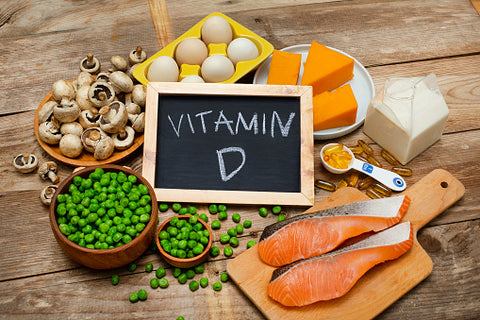
What is vitamin D3?
Share
What is vitamin D3?

What is the vitamin D3 (cholecalciferol)
Vitamin D3 (Cholecalciferol) is the natural form of vitamin D. It is essentially synthesized by the skin (superficial layers of the epidermis) thanks to the sun (exposure to ultraviolet B-rays) and is included in certain foods.
Vitamin D is actually not a vitamin in the classic sense, but a hormone, since it is synthesized by the body itself under favorable conditions if it is exposed to sunlight. Stress, pollution, Lack of sleep, the multiplication of the magnetic waves and all of thisWhat we consume in minerals, trace elements and vitamins will get us out of balance. An estimated 60 % of the population have an easy to medium vitamin D deficiency. This is an amazing Number if you knowthat most of it is produced by our own body and that short sunlight is sufficient to activate its effect.
Lack of trace elements

Lack of micronutrients, vitamins d. H. A lack of vital vitamins and minerals that the body needs in small amounts for healthy growth and healthy development.
What are the three most common micronutrient deficits?
Micronutrient deficiencies- especially vitamin A, zinc, iodine and iron deficiency- are a major problem for public health worldwide, with low-income countries in Africa and Asia bear the largest burden of illness.
Vitamins you should take
Vitamin A. Vitamin A ensures that the heart, lungs, liver and other organs work properly. ...
Vitamin D. Vitamin D Keep the bones strong by helping our body absorb calcium from food and food supplements.
Vitamin E.
Vitamin K.
Iron.
Magnesium.
Zinc.
How to take your daily vitamins

You may take many of these vitamins about your diet, but if not, what do you take?
One of the most common ways to supplement the vitamin intake is to take a single multivitamin preparation. There are many multivitamin preparations on the market and the recipe of each individual preparation is determined by the manufacturer.
In general, multivitamin preparations, most vitamins, probably together with other minerals, try to deliver in a lot that the RDA comes close to for every ingredient.
It is important for the consumer to read the label to know whether the product contains the required vitamins in the right amount. If you have any questions or need help to determine your needs, you can contact pharmacists and nutritionists.
Health advantages: What is it used for?
Vitamin D3 plays a role in calcification by fixing the fixation of calcium enabled, which is particularly necessary in the first months of life; It is therefore essential for the normal development of the skeleton. It is the anti-rachitic vitamin par excellence. It also contributes to maintaining a normal calcium and phosphorus level in the blood, which is absorbed over the intestine. It plays a role in preserving the skeletal muscles and promotes bone strength. His absence leads to disorders of calcium and phosphorus metabolism. Due to the sufficient supply of calcium and phosphorus, vitamin D also ensures better mineralization of the teeth and a stable blood sugar level, which is ideal to avoid tiredness and sweets.
Vitamin D3 deficiency
A Vitamin D3 deficiency is the cause of different bone diseases such as B. osteoporosis. A Vitamin D3 deficiency (Blood levels below 5 µg/day) leads to rachitis (deformation of the skeleton) in children and in adults to osteomalacia (lack of mineralization of the bones, which make it softer, which leads to pain in the pelvis and difficulties), which in turn the risk increased by broken bones. But unfortunately that's not all! The program also includes the risk of hyperparathyroidism, liver failure and cirrhosis. It contributes to maintaining a balanced calcium level in the blood by reducing the excretion over the urine through the kidneys.The meaning of vitamin D

- Growth and preservation of strong bones and teeth
- Functioning and recovery of the muscles
- Proper functioning of the immune system
- According to the Journal of Nutritional Science, there is sufficient evidence that a sufficient amount of vitamin D can prevent rachitis (bone formation) in small children up to 4 years.
How much do we need not to have a deficit?

Although the values can vary depending on the organism, there is agreement that the vitamin D level in the blood must be between 30 and 50 ng/ml (75-125 NMOL/L), so that values under 30 as insufficiency and below 10 ng /ml are considered a defect. A long-term deficiency can lead to serious health problems, since this vitamin is involved in important processes such as the absorption of calcium and phosphorus and plays a very important role in the nerve, muscle, heart and immune system. In order to maintain correct vitamin D values, there are recommended daily doses (RDA) for Vitamin D, over which there is also a broad consensus.
Vitamin D deficit
Vitamin D deficiency can lead to a loss of bone density, which in turn can lead to osteoporosis and broken bones. Heavy vitamin D deficiency can also lead to other diseases. He can lead to rachitis in children. Rachitis is a rare disease in which the bones become soft and bend.
Vitamin D levels
These amounts vary depending on the age of the population and the various stages of life and were determined as follows:- Infants up to the age of 12 months: 10 mcg (400 IE)
- Children aged 1 to 13 years: 15 McG (600 IE)
- Young people from 14 to 18 years: 15 McG (600 IE)
- Adults between the ages of 19 and 70: 15 McG (600 IE)
- Adults over 71 years: 20 McG (800 IE)
- Pregnant and breastfeeding women: 15 McG (600 IE)
How do you reach the recommended amount of vitamin D?
Most of the vitamin D is formed in the skin after sunlight and synthesized in the liver and kidneys and a part is absorbed through food. In order to avoid a deficit, we have to sunbathe in contrast to avoid the risks associated with the ultraviolet radiation. The time of sun exposure depends on the time of year, time of day, the latitude and skin color. While you should expose yourself to the sun for about two hours in January, 30 minutes are enough in October and 10 minutes in April to August. In general, it is assumed that three times a day 20 minutes are sufficient with uncovered face and hands.Buy vitamin D In our shop.Vitamin D rich diet
In addition, we have to pay attention to a vitamin D rich diet in the months. The food that contains the most vitamin D per 100 grams are:- Salmon: 360 ie
- Mushrooms and mushrooms: 300 IE
- Mackerel: 345 ie
- Sardines: 245 ie
- AAL: 200 IE
- Tuna: 145 ie
- Egg: 20 ie
- Arched milk (or other milk products): 100-200 IE per 250 ml.
- Vitamin D supplement capsule Vitamin D3 20000 IU
Warnings and Precautions:
Talk to your doctor or pharmacist before starting vitamin D3 when:- They are treated with drugs intended for heart disease (e.g. heart glycosides such as digoxin),
- They suffer from sarcoidosis (an autoimmune disease that is increased Vitamin D level in the body can lead, who can manifest itself in the form of nodules, mostly on the skin),
- They are treated with vitamin D-containing drugs, take vitamin D-enriched food or milk or take a sunbathing while taking this medicine, taking this medicine,
- They also take on calcium -containing nutritional supplements. Your doctor should monitor your calcium level to ensure that he Vitamin D treatment is not too high
- They have kidney disease or damage. Your doctor should monitor your calcium and phosphate values in the blood and urine,
- If you have high blood lipid levels (fat)
- if you have a liver disease. The absorption of the drug can be affected.
